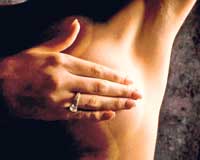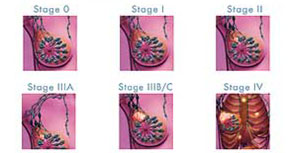
Don’t ignore the signs'Cancer' is the most dreaded word that any of us can hear when we go to the doctor for a consultation. For women in any part of the world, the most likely cancer is breast cancer. Years ago it was cancer that drew the line between life and death. With newer treatment modalities, today, everything depends on whether it's early breast cancer or a late presentation, because early breast cancer is potentially curable.
"This highlights the importance of early detection," says Dr. Nalitha Wijesundera, a Consultant Surgeon at Karapitiya Teaching Hospital. Breast cancer is the commonest cancer among women in Sri Lanka as well as worldwide. The number of cases of breast cancer detected in Sri Lanka per year is about 16 per 100, 000 population. The figure seems reassuring when compared to American countries that have a figure around 70 per 100,000 population. "But the rates have been on the rise, almost doubled during the past 15 years," warns Dr.Wijesundera. In our country about half the number of patients present symptoms at an early stage. Although it is satisfactory compared to other South Asian countries, the target should be to detect ninety percent of the patients at an early stage. "Once detected early, breast cancer can successfully be treated with surgery and chemotherapy and the patient can lead quite a normal life afterwards. Thus, the implication is that we should start screening early," stresses Dr. Wijesundera adding that the most number of patients are diagnosed with breast cancer between 41 and 45 years. This too, stresses the importance of screening from young age. Screening Mammography is the ideal screening method which should ideally be done once in every eighteen months after 50 years till you are seventy. But if an immediate family member like your mother or sister, had a breast cancer, , then annual mammography and examination by a doctor is indicated. If you are less than 35 years with strong risk factors for breast cancer, screening has to be done using ultra sound scan, because it visualizes lesions better in younger women.
However, in a country like ours with scarce resources, it is not feasible to make available free mammograms for everyone. There are mammography machines at the National Hospital, Cancer Institute, Maharagama, Kandy and Karapitiya. Teaching hospitals in the government sector are to be utilized to diagnose breast cancer in patients who present with lumps, nipple discharges etc. For screening purposes, a mammogram can be done at a cost of about Rs. 1500 at the National Hospital Breast Health Centre and in the private sector and anyone can access this service. Self breast examination is an important tool to detect cancer early. Hence, it is recommended that all women after their puberty should perform self breast examination once a month. Risk factors Breast cancer is 100 times commoner among females but being a male does not exclude you from the risk of having it. In women the risk increases with age. When a woman has a breast cancer in one breast, the chances of her getting it in the other breast are quite significant, so regular surveillance is mandatory. Also if a first degree relative of yours has a breast cancer it will increase your risk of having it too. "In these instances, self breast examination is not enough, regular mammography has to be done," says Dr. Wijesundera. Early age of menarche, before 12 years and late menopause also increase the risk. But increased risk does not necessarily mean that you are going to get it. Having your first child at an early age, preferably before 20, and also breast feeding reduces the risk. If you are on hormone replacement therapy following menopause, it increases the risk but not hormonal contraceptive pills. Treatment If your lump is not cancer, you do not necessarily need to get it removed, if you are less than 35 years. But you need to keep a tab on whether it is increasing in size. It is not wise to take risks in a woman who is more than 35 years. Then the lump must be removed and examined under the microscope to be sure that it's not cancer. If it is not cancer, you can just forget it and it is not going to cause cancer in later life. But, you need to examine your breasts monthly. Frightening though it may be, life does not end there, if you are diagnosed with cancer. There are various treatment modalities including surgery, hormonal therapy, chemotherapy and radiotherapy. Choosing between these options or using combinations depend on the stage of the cancer and various molecular characteristics of it.
If the cancer is small, not involving the nipple or areola, only the lump can be removed with an adequate margin. But with larger lumps, it is necessary to remove the whole breast, which is called mastectomy. Having to undergo mastectomy in the early forties adds to the agony in a woman who is already depressed with the fear of cancer. But new surgical techniques have minimized the cosmetic problems. "Breast reconstruction is widely practised today, in Sri Lanka," Dr. Wijesundera explains. It can be done immediately after the breast is removed, by filling the defect with a muscle from elsewhere. Or else, reconstruction is possible after a few months, once the patient is comfortable about proceeding with it. Silicon and other implants can also be used for this purpose. The scar is the other problem which worries patients even when a harmless lump is removed. But, the incision is well planned beforehand to make the scar less prominent. When only the lump is removed the incision is usually made around the areola so that it is not visible. Follow - up The mysterious nature of breast cancer is that even if all the evidence of cancer is removed by surgery and other modes of treatment, it can have 'micrometastasis'. This means a few cancerous cells could have spread to another site, which is usually not detectable. Thus, a patient can present with recurrence even after 20 years of treatment. Therefore lifelong follow-up is indicated. This does not prevent you from attending to your routine work; follow-up is initially done once in three months for 2 years, 6 monthly for about 5 years and annually thereafter. |
|| Front
Page | News | Editorial | Columns | Sports | Plus | Financial
Times | International | Mirror | TV
Times | Funday
Times | Medi Scene || |
| |
Reproduction of articles permitted when used without any alterations to contents and the source. |
© Copyright
2007 | Wijeya
Newspapers Ltd.Colombo. Sri Lanka. All Rights Reserved. |

